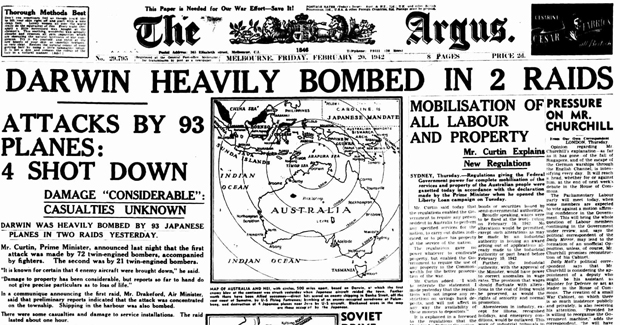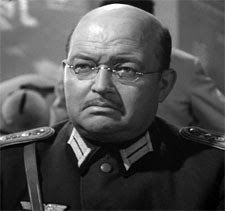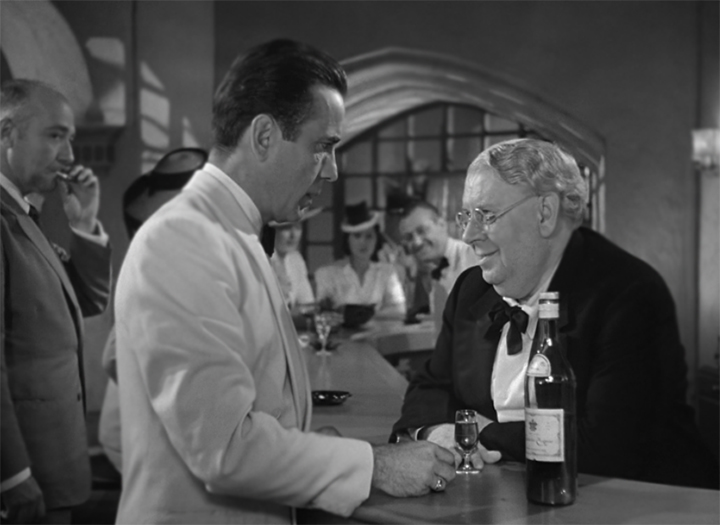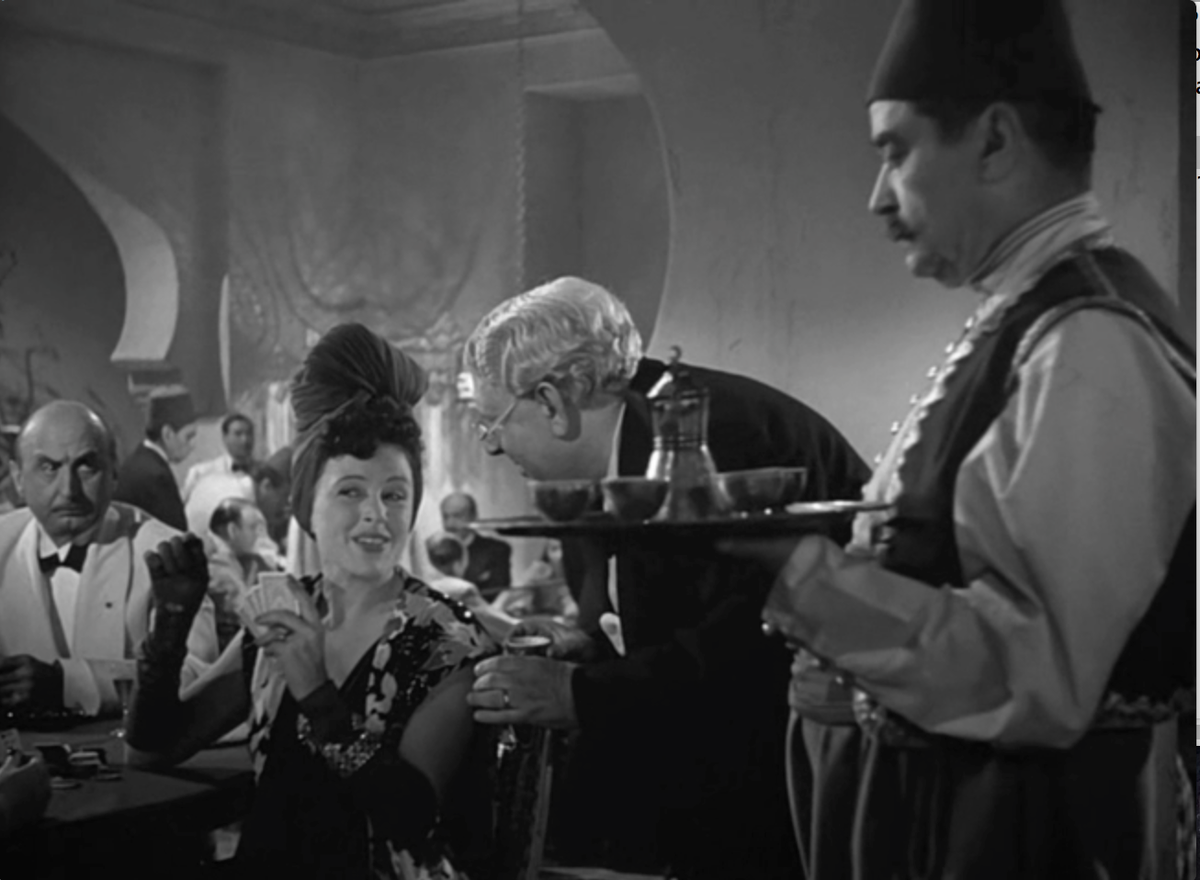 (AP Images)
(AP Images) One of Hollywood's most beloved movies, watched by THC countless times, and the source of countless quotable lines like, for instance, this one:
began principal photography on this date in 1942. Casablanca starred Humphrey Bogart, Ingrid Bergman and Claude Rains. Watching it today with the knowledge of how World War II turned out is a different experience from what it must have felt like during the shooting, which wrapped on August 3. We'll take a little time today to set the scene in the late spring and early summer of 1942, when the outcome of the war was very uncertain and then tell the story of the large group of emigres who had fled the Nazis and had roles in the the film.
--------------------------------------------------------------------------------------------------
By May 1942, the United States had been at war for five months. It had been a bleak start to the war. In the Pacific, Japan destroyed the American battleship fleet with its surprise attack on Pearl Harbor and was continuing its rampage on land and sea. In Southeast Asia, Japanese forces had overrun Malaya, Burma, the Dutch East Indies (now Indonesia) and forced the humiliating surrender of 75,000 British Commonwealth troops at Singapore. Allied naval forces in that region had been destroyed at the Battle of the Java Sea, and Japanese carriers had raided as far afield as Ceylon (Sri Lanka) and bombed the town of Darwin on Australia's northern coast.
 In China, the British colony of Hong Kong had been overrun and Japanese forces continued their advance into the interior of the country. On December 22, 1941, Japan had invaded the Philippines and by the date filming began the entire island chain had been conquered except for the small island of Corregidor at the entrance to Manila Harbor, which was to surrender on May 8. The prior month saw the Bataan Death March in which up to 10,000 Filipino and American prisoners of war died due to brutal treatment by their Japanese captors.
In China, the British colony of Hong Kong had been overrun and Japanese forces continued their advance into the interior of the country. On December 22, 1941, Japan had invaded the Philippines and by the date filming began the entire island chain had been conquered except for the small island of Corregidor at the entrance to Manila Harbor, which was to surrender on May 8. The prior month saw the Bataan Death March in which up to 10,000 Filipino and American prisoners of war died due to brutal treatment by their Japanese captors.The island chains of the central Pacific had also been occupied and Japanese forces were advancing on Port Moresby in New Guinea and southward down the Solomons Island chain with an eye to severing communication links between Australia and the United States. Earlier that month came the first glimmer of good news when, at the Battle of the Coral Sea, American naval forces fought the Japanese to a draw, causing them to temporarily put their plans for capturing Port Moresby on hold.
Nor was there much good news in the European theater. Much of Europe lay under Nazi occupation or controlled by their allies. Poland, Czechoslovakia, Yugoslavia, Greece, Belgium, Luxembourg, the Netherlands, Denmark, Norway and France were under direct Nazi control, though part of France was governed by the collaborationist Vichy regime. Italy, Hungary, Romania, Bulgaria and Finland were Nazi allies. Franco's Spain was nominally neutral, though leaning towards the Axis. Only Britain still stood defiant in western Europe.
In the East, the Soviets had managed to stop the surprise Nazi attack of June 22, 1941 before the gates of Moscow during the winter of 1941-2. By spring the front had stabilized, deep within the former Soviet borders and million of soldiers and civilians lay dead. During May, Soviet offensives around Kharkov and on the Crimean peninsula misfiring leaving 470,000 of its soldiers dead, wounded or captured at a cost to the Germans of only 29,000 casualties.

Mass shooting of Soviet Jews had begun with the invasion of June 1941, but it was only with a 90 minute conference at a home in the Berlin suburb of Wannsee on January 20, 1942 that final agreement was reached on the logistical details for the killing all 11 million European Jews, and by May 25, 1942 the Nazi extermination camps in Poland were either under construction or already operating (for a chilling theatrical account of the Wannsee meeting watch Conspiracy, a 2001 film starring Kenneth Branagh as Reinhard Heydrich, the SS officer who chaired the conference).
In North Africa, the Vichy collaborationist regime controlled Morocco (including Casablanca). Algeria and Tunisia and the German army under the command of General Erwin Rommel was advancing in Libya against British, Australian and New Zealand forces.
And closer to the United States, the Battle of the Atlantic was not going well. German U-boats were roaming the ocean, taking a huge toll on allied shipping, particularly that of the U.S. which was ill-prepared to protect its merchant ships. From January to August of 1942, 609 Allied ships were sunk in the Atlantic, including a number right off the east coast of U.S.
By the time filming wrapped on August 3, 1942 there had been some good news from the Pacific, where the outnumbered American fleet sank four Japanese carriers at the Battle of Midway, thwarting Japanese plans to lure the remnants of the American navy to its destruction. Though not immediately apparent, the battle spelled the end for Japan's Pacific onslaught.
The news from Europe though was almost uniformly bad. In the East, the German army launched a huge offensive on June 28, designed to bring all of southern Russia and the oil fields of the Caucausus under its control. By early August, German panzers were advancing quickly, headed for a large, and symbolic, city on the Volga River - Stalingrad.
In Libya, the Battle of Gazala began the day after filming started and raged until June 21. At one point, it looked as though the Allies would defeat Rommel but the tide turned and led to a catastrophe, the fall of Tobruk and the surrender of 25,000 Commonwealth soldiers. Churchill later called it the most shocking moment of the war and it triggered a Parliamentary no-confidence vote regarding the Prime Minister (which he survived). Rommel pursued the shattered Allied forces and by early August was in Egypt, only sixty miles from Alexandria.

(German armored vehicles, including Rommel's command vehicle on right, Battle of Gazala, from wikipedia)
By the time Casablanca had its premiere in New York City on November 26 and was released nationally on January 23, 1943 the global situation had brightened some. The premiere was accelerated because of major news - on November 8, American and British troops landed in North Africa, and one of the three landing places was Casablanca! And the national release took place while President Roosevelt and Prime Minister Churchill were in Morocco meeting at the Casablanca Conference (January 14-24). By that time Axis forces had been thrown out of Morocco and Algeria and Rommel had defeated in Egypt and began his long retreat across Libya to Tunisia.
In the Soviet Union, a massive surprise attack on November 19 by the Soviets had succeeded in surrounding the German 6th Army at Stalingrad (where it would surrender at the beginning of February) while in the Pacific, the Marines had landed on Guadalcanal and survived ferocious Japanese land, air and naval assaults. The future was beginning to look better.
--------------------------------------------------------------------------------------------------
The cast of Casablanca reflected the world's turmoil. Many had fled Europe.
The last surviving cast member, Madeleine Lebeau died earlier this month at the age of 92. Born in France, she fled Paris with her Jewish husband just before the Nazi occupation began in 1940. They made it to Lisbon and from there to Mexico, where they were detained when it was discovered that their Chilean visa was forged, finally making it to America on a temporary Canadian passport. In this, her third Hollywood film, she played Yvonne, who can be seen singing during the Marseillaise scene.
 (From Deadline Hollywood)
(From Deadline Hollywood)Madeleine's husband was a Romanian Jew, Marcel Dalio, who plays Emil the croupier at Rick's Cafe.
 (Dalio from Wikimedia)
(Dalio from Wikimedia)Paul Henreid (Victor Laszlo) emigrated from Austria in 1935, after a fascist government came to power.
 (Henreid from Pininterest)
(Henreid from Pininterest)The villainous Nazi Major Heinrich Strasser was played by Conrad Veidt who had been a major film star in Germany, achieving fame as the murderous Cesare in 1920's The Cabinet of Dr Caligari. He fled Germany with his Jewish wife in 1933 when Hitler came to power. Strasser's adjutant, Colonel Heinze was Richard Ryen, a Hungarian actor expelled from Germany by the Nazis.
 (Ryen from lockerdome)
(Ryen from lockerdome)Another former German film star was Peter Lorre (Signor Ugarte), who became famous for the title role in M (1931). He also left Germany in 1933.
The actor playing Carl, a waiter at Rick's, was SK Sakall, a Hungarian Jew, who had been a popular actor in Germany and Austria. Forced to return to Hungary in 1933, he emigrated after Hungary became a German ally in 1940. Three of his sisters and many other family members were killed in the camps. The bartender at Rick's, Sascha, was Leonid Kinsky, who'd fled Russia in the midst of its revolution in 1917. That's Kinsky in the photo above with Ms Lebeau.

(Sakall from natedsanders)
The pickpocket you see in one of the early scenes of the film was played by Curt Bois, a German Jew who fled the country in 1934.
Helmut Dantine - Jan, the Bulgarian boy, whose wife comes to Rick for advice, grew up in Vienna, where he was an active anti-Nazi. After the German takeover of Austria in 1938 he was briefly detained in a concentration camp before his parents were able to obtain his release and send him to America.
In the first scene of the movie an actor can be seen muttering "waiting, waiting, waiting....I'll never get out of here....I'll die in Casablanca." That's Louis V Arco (real name - Lutz Atschul), who left Germany in 1933 and then his native Austria in 1938.
The actress who asks Carl the waiter "Will you ask Rick if he will have a drink with us?", to which Carl responds, "Madame, he never drinks with customers. Never. I have never seen it.", setting up that wonderful moment when Rick sits down to drink with Victor Laszlo and Ilsa, is Trude Berliner. Berliner was a famous cabaret performer in Berlin and appeared in four German movies with SK Sakall, who plays Carl. Berliner left Germany in 1933.
 (Berliner, asking for Rick)
(Berliner, asking for Rick)A well known German Jewish actress, Ilka Grunig also left Germany after 1933. She plays part of a husband/wife combo who have one amusing scene in which they are practicing their English. Ludwig Stossel, who plays her husband, fled Germany in 1933 to return to his native Austria, where, as a Jew, he was imprisoned several times after the Nazi takeover before escaping Vienna. Here they are as Herr & Frau Leuchtag.
The man with expired papers shot by Vichy police at the beginning of the film is Wolfgang Zilzer, another Jewish actor who fled Germany.
Given the times and the people involved it is not surprising that the "battle of the anthems" scene was an emotional highpoint for many in the cast.
Your well done history lesson and commentary will make a great movie better. I'll have to play it again, Mark. dm
ReplyDelete